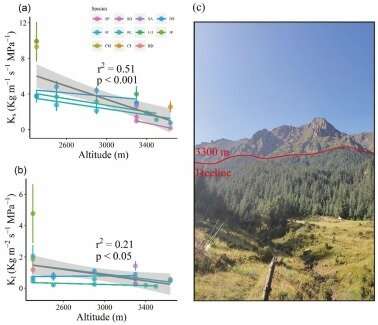Forest community dynamics and the response to climate change in Qilian Mountains

Qilian Mountains, an important mountain range in the arid area of northwest China, is not only an important gathering place of biodiversity but also a water supply area of Hexi Corridor.
Forest is an important part of Qilian Mountains ecosystem. It is significant to understand forest community dynamics and its response to climate change for ecological environment management and ecosystem protection in Qilian Mountain.
A research team from the Northwest Institute of Eco-Environment and Resources (NIEER) of the Chinese Academy of Sciences (CAS) investigated responses of subalpine shrub community species diversity to climate change on the Northern Slope of Qilian Mountains, including spatial differentiation of phenological, phenotype and its internal mechanism in Picea Crassifolia and physiological mechanism of alpine tree line formation in alpine mountains.
The researchers analyzed changes of subalpine shrub community species composition in 2002 and 2007. They found that climate warming in Qilian Mountains changed the pheological pattern of dominant shrub community: the shaded and wet-tolerant herbaceous species increased in the low-altitude areas, while the sun-like species decreased in the high-altitude areas.
The study also showed that all phenological stages of Picea Crassifolia were delayed by 0.57–1.36 d/100m with altitude, and the heat accumulation, precipitation and frequency of freezing injury before the beginning of the growing season were the key factors affecting the phenological dynamics.
In addition, forest lines are sensitive to climate change and determine the change of forest community. Research on more than 10 dominant woody plants on the Northern Slope showed that water conductivity and photosynthesis of plants decreased with the increase of altitude and the decrease of air temperature, which may be the physiological mechanism affecting the alpine tree line.
Related results were published in International Journal of Biometeorology, Forest Ecology and management and Chinese Journal of Plant Ecology.
More information: Jun Du et al, Impact of climate change on alpine plant community in Qilian Mountains of China, International Journal of Biometeorology (2021). DOI: 10.1007/s00484-021-02141-w
Xiangyan Feng et al, The physiological constraints of alpine treeline in Qilian Mountains, Forest Ecology and Management (2021). DOI: 10.1016/j.foreco.2021.119761
Journal information: International Journal of Biometeorology , Forest Ecology and Management
Provided by Chinese Academy of Sciences





















